Fundación ProAves Reserves protected by the new AZE fund.
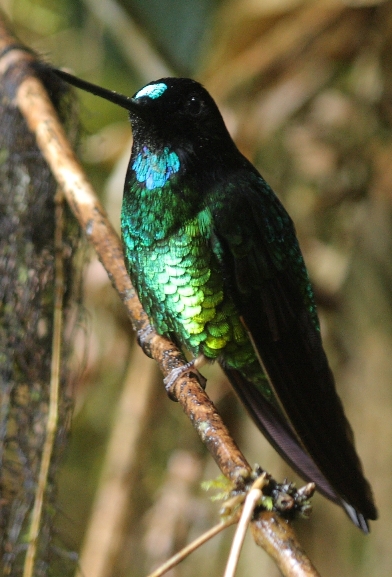 |
|
Dusky Starfrontlet (Coeligena orina). |
This nature reserve of 1,801 acres (729 hectares) in western Colombia encompasses both dense forest and high-altitude plains that are characterized by high levels of species found nowhere else. An expedition to this region in 2004 led to the rediscovery of the Critically Endangered dusky starfrontlet (Coeligena orina) that had not been seen for 50 years. This reserve also provides refuge for other threatened species, such as the chestnut-bellied flowerpiercer (Diglossa gloriosissima). Colibri de Sol is expected to become a new AZE site in the next species update for the dusky starfrontlet.
Named after the legendary city of gold for its tremendous conservation value, this, 2.532 acres (1.024 hectares) nature reserve protects the highest concentration of site-restricted and threatened birds and amphibians in the world. It is a refuge for the core breeding population of the Santa Marta parakeet (Pyrrhura viridicata). One of more than 20 endemic birds here, the parakeet derives its name from a 19,000-foot massif that rises from the Caribbean. The reserve is tucked between the glaciers of the Sierra Nevada and the mangroves of Ciénaga Grande de Santa Marta, and is part of the Parque Nacional Natural Sierra Nevada de Santa Marta AZE site.
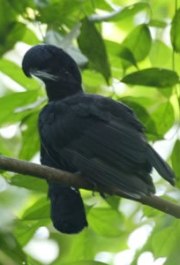 |
| Long-wattled umbrellabird (Cephalopterus penduliger). |
It rains up to 23 feet (seven meters) each year on this 20,613 acres (8,342 hectares) reserve. Lush with vegetation, this site sits in the heart of one of the world’s wettest and most biologically unique regions. It spans the Rio Ñambí Valley, rising from lowland wet forest to upper subtropical cloud forest, and is home to many endemic birds, including the Endangered Chocó vireo (Vireo masteri), discovered in 1991.
This 7.956 acres (3,219 hectares) nature reserve is a home to a core population of Colombia’s most enigmatic species: the Critically Endangered blue-billed curassow (Crax alberti), known locally as “El Paujíl.” An important symbol in ancient pre-Colombian indigenous culture, this bird was virtually unknown until an expedition in 2003 located a viable population in the humid lowland forest of the Magdalena valley. Since having been afforded protection in the reserve, the species’ population has increased by 20 percent each year.
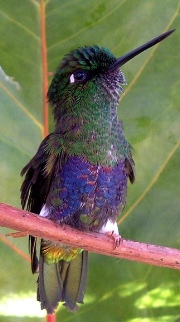 |
| Colourful Puffleg (Eriocnemis mirabilis). |
The aptly named colorful puffleg (Eriocnemis mirabilis) – one of the world’s most threatened and enigmatic hummingbirds – is an extreme habitat specialist and dependent on the wet montane forest on the Pacific slope of the west Andes that’s protected by this 3,405 acres (1,378 hectares) reserve. Discovered in 1967, this Critically Endangered species is estimated at only around 50 to 250 birds.
A global stronghold for gorgeted wood-quail (Odontophorus strophium) and mountain grackle (Macroagelaius subalaris) – both Critically Endangered birds that depend on this 513 acres (207 hectares) fragment of natural forest – this nature reserve is also South America’s first protected area for a migratory songbird; it provides shelter for a core population of wintering cerulean warbler (Dendroica cerulea). While not an AZE species, the cerulean warbler is losing habitat in its North American nesting grounds as well as in subtropical forests.
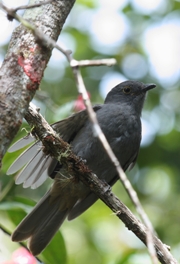 |
|
Chestnut-capped Piha (Lipaugus weberi). |
The Chestnut-capped Piha Bird Reserve was created to protect the habitat of Chestnut-capped Piha (Lipaugus weberi), on 27 November 2006. It has an area of approximately 1.323 hectares and is classified according to the Alliance for Zero Extinction as an AZE site. It is located in the El Roble, Anorí (Antioquia), with an altitude between 1,400 and 1,850 m above sea level.
The Andean Parrots Birds Reserve was established on 21st April 2009 with the aim of protecting the habitat of five endangered species of parrots among we have the Yellow-eared Parrot (Ognorhynchus Icterotis) (CR), the Fuertes’s Parrot (Hapalopsittaca fuertesi) (CR) and Rufous-fronted Parakeet (Bolborhynchus ferrugineifrons) (VU), and also preserve the Golden-plumed Parakeet (Leptosittaca branickii) (VU) and the Rusty-faced Parrot (Hapalopsitaca amazonina) (VU) and 10.063 acres of conservation Andean forest and moorland in the town of Roncesvalles Tolima.
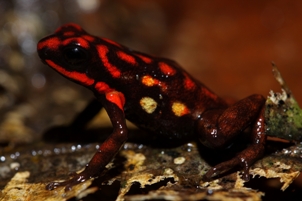 |
| Ranitomeya doriswainsonae. |
Ranita Dorada Amphibian Reserve, the first in the world created for the conservation of threatened species in this order, was established in December 2008, with the contribution of important institutions such as IUCN Netherlands, Dendrobatidae Nederland, Conservation International and Netherlands Postcode Lottery,in order to preserve a piece of subtropical forest inhabited by two endemic and endangered Colombia: Ranitomeya doriswainsonae and Ranitomeya tolimense, described in 2006 and 2007 respectively.
The Niceforo’s Wren Bird Reserve was founded in 2009 with the support of World Land Trust, American Bird Conservancy and the Corporación Autónoma Regional de Santander, based on the urgency of conserving one of the most threatened ecosystems in Colombia and the world, tropical dry forest, habitat of many animal and plant species unique to this particular ecosystem. It has two species of endemic and threatened birds Chicamocha Canyon, Niceforo’s wren (Thryothorus nicefori) and Chestnut-Bellied Hummingbird (Amazilia castaneiventris), two species and three subspecies of endemic birds and a threatened species of cactus.
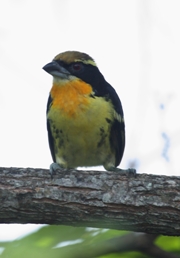 |
| Gilded Barbet (Capito auratus). |
The Orange-breasted Falcon Bird Reserve was established in August 2008 with the aim of preserving a sample of the habitat of Orange-breasted Falcon (Falco deiroleucus) and preserve in perpetuity one of the most vulnerable landscapes in Colombia, the piedmont plains affected by the extension of the livestock border.
Admission and tours:
Contact EcoTurs headquarters Carrera 20 Nº 36 – 61, Bogotá, Colombia, phone (57) (1) 245-5134 and (57) (1) 340 -3285, send emails to info@ecoturs.orgThis e-mail address is being protected from spambots. You need JavaScript enabled to view it You need JavaScript enabled to view it or visit www.ecoturs.org
